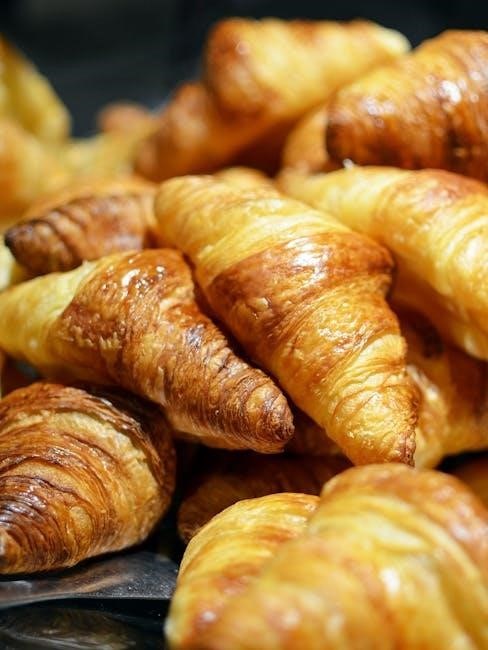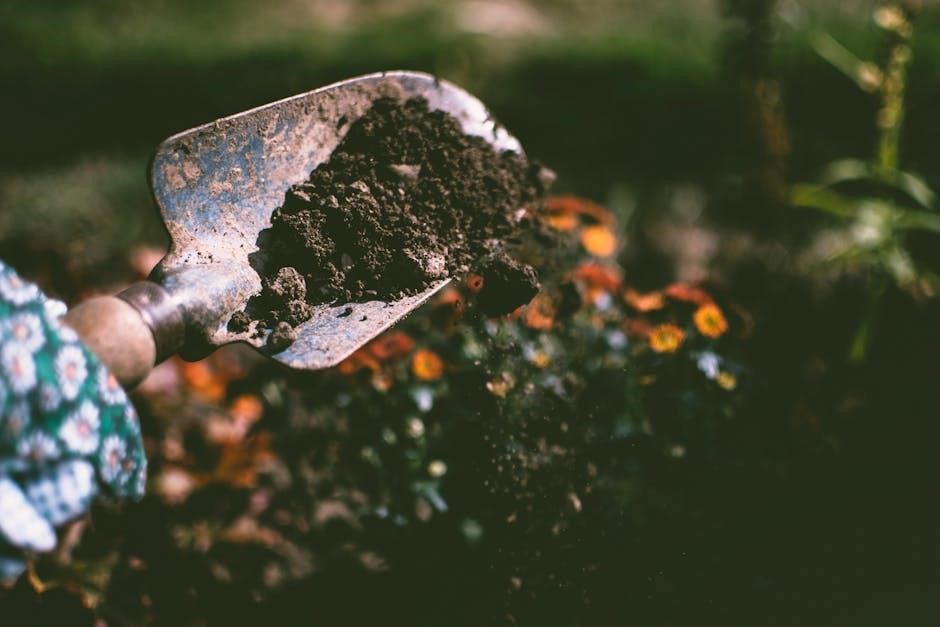A manual butter churn is a traditional kitchen tool used to transform cream into fresh, homemade butter through mechanical agitation, offering control, freshness, and a delightful homemade experience.
What is a Manual Butter Churn?
A manual butter churn is a mechanical device used to transform cream into butter by agitating the fat molecules until they clump together, separating from the buttermilk. It typically features a container, a paddle or dasher, and a hand-crank mechanism. This traditional tool allows users to create fresh, homemade butter with minimal effort, offering a simple and eco-friendly alternative to electric appliances.
History and Evolution of Manual Butter Churns
Manual butter churns date back centuries, originating from ancient techniques of shaking cream in animal stomachs or wooden containers. Over time, churns evolved, with medieval Europeans using wooden barrels and plungers. The 19th century saw the introduction of hand-crank models, making churning easier. Today, manual churns remain popular for their simplicity and ability to produce high-quality, homemade butter, preserving a timeless culinary tradition.

Types of Manual Butter Churns
Manual butter churns vary in design, from traditional wooden models to hand-cranked and modern innovations, each offering unique benefits for homemade butter enthusiasts.
Traditional Wooden Butter Churns
Traditional wooden butter churns are timeless tools, often passed down through generations. Crafted from durable wood, they feature a screened pour spout and a paddle or dasher. These churns require manual effort, offering a nostalgic and rewarding experience. Regular maintenance, like lubricating gears with food-grade oils, ensures longevity. Their charm lies in their simplicity and ability to connect users to ancestral cooking methods, preserving the art of homemade butter-making.
Hand-Crank Butter Churns
Hand-crank butter churns are versatile and user-friendly, featuring a container with a paddle or dasher and a manual crank. Simply pour in cream, turn the handle, and watch as the fat globules clump into butter. These churns are efficient, requiring about 15-45 minutes of cranking, depending on cream quantity and fat content. Ideal for homemade butter enthusiasts, they combine simplicity with satisfying results.
Modern Manual Butter Churn Designs
Modern manual butter churns blend tradition with innovation, offering sleek designs and improved functionality. Many feature easy-clean materials, ergonomic handles, and compact builds. Some incorporate multi-use jars for convenience, while others include accessories like butter paddles and molds. These designs cater to both novice and experienced users, making homemade butter-making accessible and enjoyable with updated, user-friendly features.
Advantages of Using a Manual Butter Churn
Manual butter churns offer precise control, superior flavor, and texture, allowing for customization. They promote sustainability and cost-efficiency, providing fresh, high-quality butter without reliance on electricity or preservatives.
Control Over the Churning Process
Manual butter churns provide unparalleled control, allowing users to monitor and adjust the churning process precisely. This ensures the desired consistency, whether creamy or whipped, and prevents over-churning. The tactile experience enables immediate adjustments, making it easier to achieve perfect results tailored to personal preference, ensuring high-quality, customizable homemade butter with every use.

Cost-Effective and Eco-Friendly
Manual butter churns are a cost-effective and eco-friendly option for homemade butter, eliminating the need for electricity and reducing energy costs; They often use durable, reusable materials, minimizing waste. This sustainable approach allows users to enjoy fresh butter while lowering their environmental impact, making it a budget-friendly and environmentally conscious choice for home use.
Improved Flavor and Texture of Homemade Butter

Manual butter churns allow for precise control over churning, resulting in a richer, creamier texture and more vibrant flavor compared to store-bought butter. By using fresh, high-quality cream, homemade butter retains natural sweetness and a velvety smoothness. This method also avoids additives, ensuring a pure, authentic taste that enhances cooking and baking experiences.

Selecting the Right Cream for Churning
For optimal results, use high-quality heavy cream with a high fat content, preferably non-ultra-pasteurized, to ensure smooth churning and rich, flavorful homemade butter with a creamy texture.
Heavy Cream vs. Regular Cream
Heavy cream, with a fat content of 36-40%, is ideal for churning butter due to its richness and ease of separation. Regular cream, typically 20-30% fat, is less efficient and may not yield as much butter. Heavy cream ensures a smoother, creamier texture and faster churning, making it the preferred choice for homemade butter production compared to regular cream.
Importance of Fat Content in Cream
Fat content is crucial for successful butter churning, as it directly impacts the quality and quantity of butter produced. Cream with higher fat percentages, typically 36-40%, churns more efficiently, resulting in richer, creamier butter. Lower fat content requires more effort and time, often yielding less butter and a less desirable texture, emphasizing the importance of selecting high-fat cream for optimal results.
Pasteurization and Ultra-Pasteurization Considerations
When using a manual butter churn, it’s important to consider the type of cream. Pasteurized cream is ideal as it retains the necessary fat structure for easy churning. Ultra-pasteurized cream, however, has been heated to higher temperatures, which can disrupt fat molecules, making it harder to separate into butter. Always opt for pasteurized cream for better results.
Step-by-Step Guide to Using a Manual Butter Churn
Start by preparing your churn and cream, ensuring all parts are clean. Pour heavy cream into the churn, then turn the handle steadily until butter granules form and separate from buttermilk.
Preparing the Churn and Cream
Begin by sterilizing the butter churn with a 50/50 mix of white vinegar and water to eliminate bacteria. Rinse thoroughly with clean water. Ensure the cream is at room temperature, ideally around 60°F, and not ultra-pasteurized. Pour the heavy cream into the churn, filling it no more than two-thirds full to allow space for churning. Let it sit for 30 minutes to warm up before starting the process.
The Churning Process
Begin churning by turning the handle steadily, allowing the cream to agitate and form fluffy whipped cream. Continue until the mixture thickens, and butter granules start clumping together, separating from the buttermilk. Stop when the butter becomes chunky and difficult to churn further, typically within 15 to 45 minutes, depending on the cream and churn efficiency.
Separating Butter from Buttermilk
Once the butter granules clump together, stop churning. Pour off the buttermilk into a separate container. Transfer the butter to a bowl, rinse with cold water to remove remaining buttermilk, and drain thoroughly. Gather the butter, ensuring no liquid remains, and proceed to shape or season it as desired for storage or immediate use.

Washing and Preparing the Butter
Transfer the butter to a bowl, add cold water, and mix until the water turns cloudy. Drain and repeat until water remains clear. Pat dry gently to remove excess moisture, ensuring freshness and preventing spoilage.
Rinsing the Butter
Transfer the butter to a bowl and add cold water. Use a spoon or fork to gently mix until the water becomes cloudy. Drain and repeat until the water remains clear. This process removes excess buttermilk, preventing spoilage and ensuring freshness. Repeat rinsing until the butter is thoroughly cleaned for a longer-lasting, purer product.
Removing Excess Buttermilk
Pour off the buttermilk from the churn into a separate container. Use a wooden spoon or spatula to gently press the butter, releasing any remaining liquid. Repeat this process until minimal buttermilk is visible. This step ensures the butter is dry and fresh, improving its texture and shelf life. Be thorough to avoid spoilage.
Drying the Butter
After rinsing, use a clean surface or butter paddles to gently press out remaining moisture. Drain thoroughly to remove any excess liquid. This step is crucial to prevent spoilage and ensure freshness. Proper drying helps the butter last longer and maintains its quality. Use a clean, cool surface to pat dry, ensuring no buttermilk residue remains.

Adding Salt and Shaping the Butter
Add salt to enhance flavor and texture, then shape the butter using paddles or molds for a professional finish, ensuring it’s ready for storage or serving.
Salting the Butter
Sprinkle salt evenly over the butter, using about 1/4 teaspoon per 4 ounces. Gently knead the salt into the butter with your hands or a spatula until fully incorporated.
This enhances flavor and improves shelf life. Ensure the butter is well-rinsed of buttermilk before salting to prevent spoilage and savor the homemade taste.
Using Butter Paddles or Molds
Transfer the butter to a mold or shape it using butter paddles for a smooth finish. Press firmly to remove any remaining buttermilk. For uniform shapes, use a traditional wooden or modern silicone mold. If no mold is available, simply shape the butter into a roll or block for storage or serving.
Storing the Finished Butter
Once shaped, store the butter in an airtight container to prevent exposure to air, which can cause spoilage. Keep it refrigerated to maintain freshness for up to two weeks. For longer storage, wrap tightly and freeze, though freezing may slightly affect texture. Ensure containers are clean and dry to preserve quality and flavor.
Tips for Maintaining Your Manual Butter Churn
Regularly clean and sanitize the churn with a 50/50 vinegar-water solution. Lubricate moving parts with food-grade oil, like coconut or olive oil, to ensure smooth operation. Store properly in a dry place to prevent rust or damage, ensuring longevity and optimal performance for future use.
Cleaning and Sanitizing the Churn
Clean and sanitize the churn using a 50/50 mix of white vinegar and warm water. Scrub all surfaces that contact butter or buttermilk, including the jar, paddles, and spout. Rinse thoroughly with clean water. Vinegar effectively kills bacteria without toxicity, ensuring a safe and hygienic churning process. Regular cleaning prevents contamination and extends the churn’s lifespan.
Lubricating Moving Parts
Lubricate the churn’s moving parts with food-grade oils like coconut or olive oil to ensure smooth operation. Avoid petroleum-based lubricants, as they can contaminate the butter. Regular lubrication prevents wear and tear, keeping the mechanism efficient and extending the lifespan of the churn. This simple maintenance step ensures optimal performance for every churning session.
Storing the Churn Properly
After cleaning and drying, store the churn in a cool, dry place. Ensure all parts are completely dry to prevent rust. For extended storage, apply a light layer of food-grade oil to moving parts to protect them from corrosion. Proper storage maintains the churn’s condition, ensuring it remains ready for future use.

